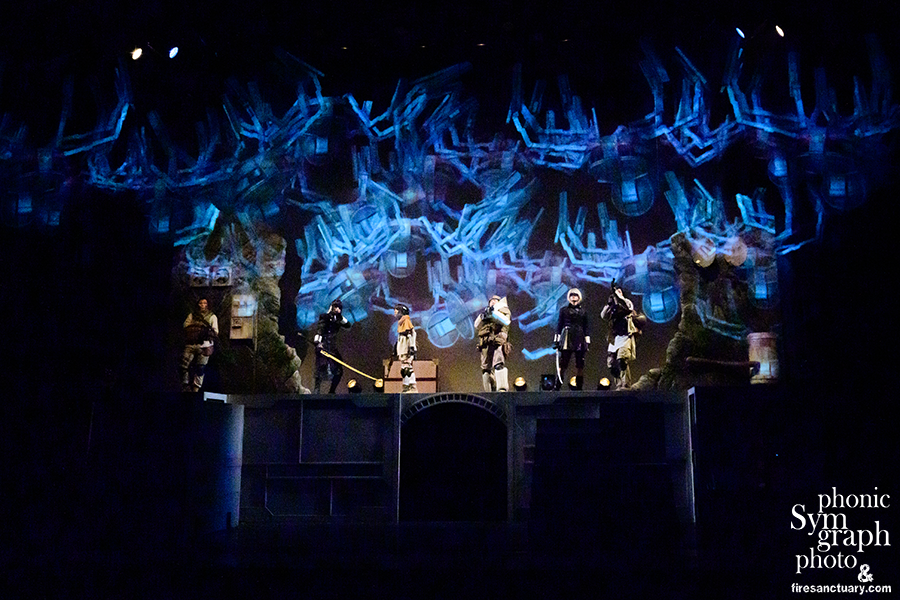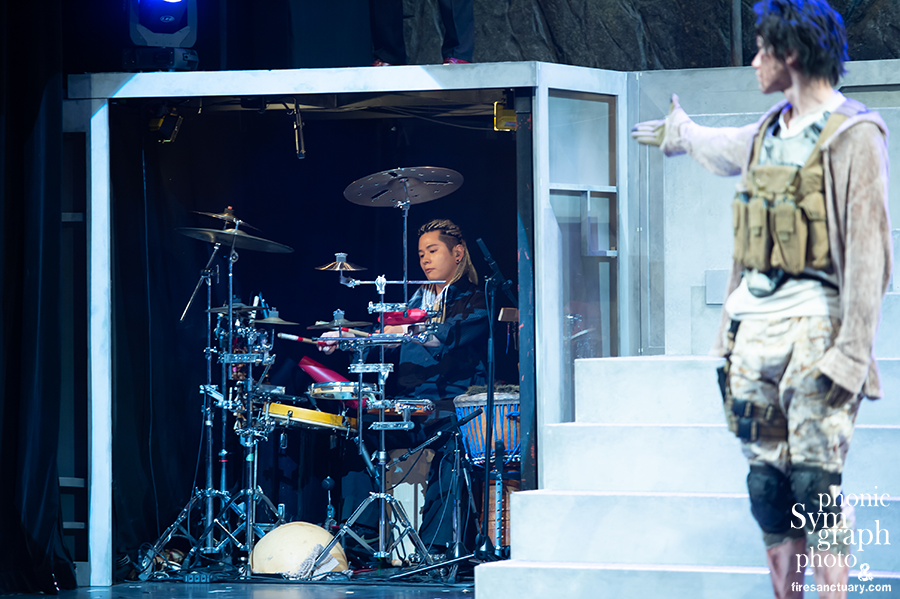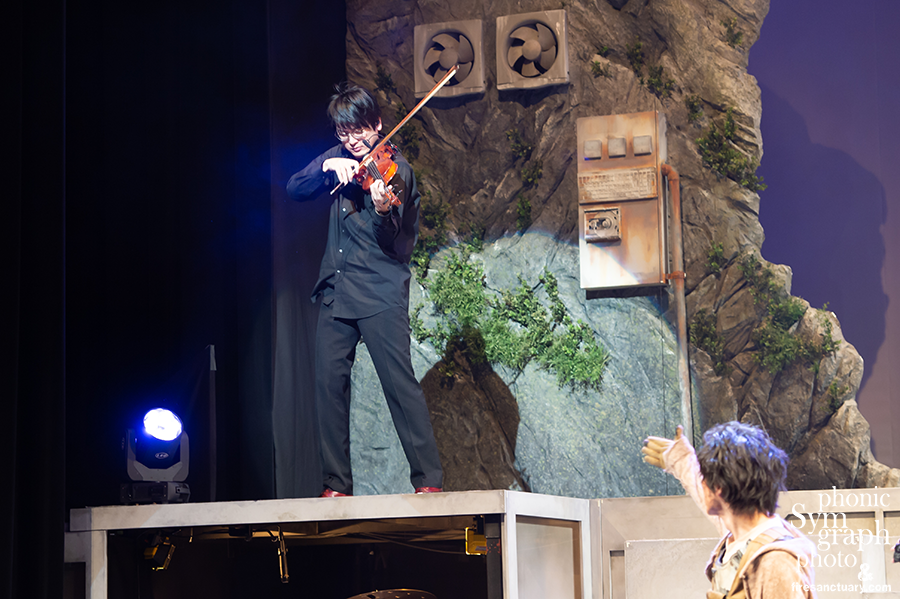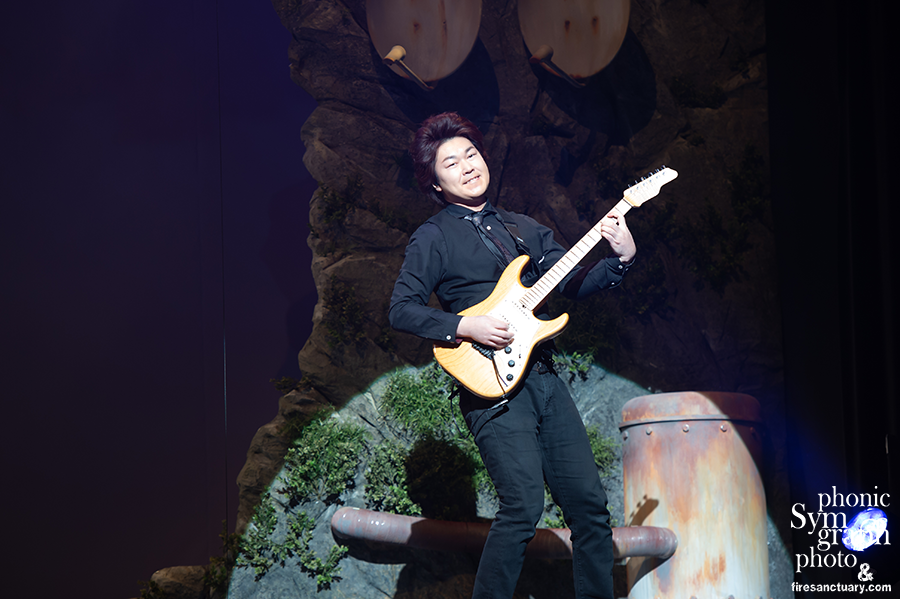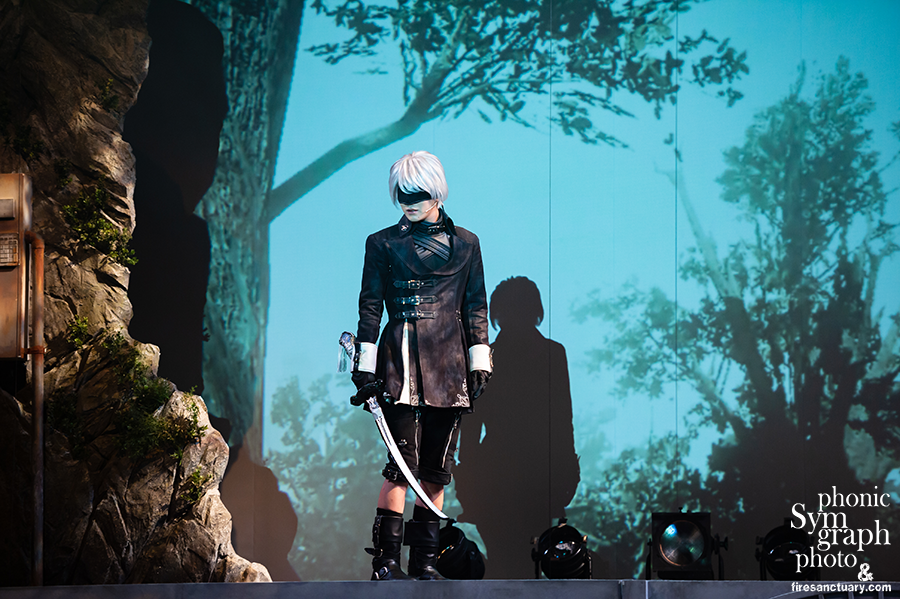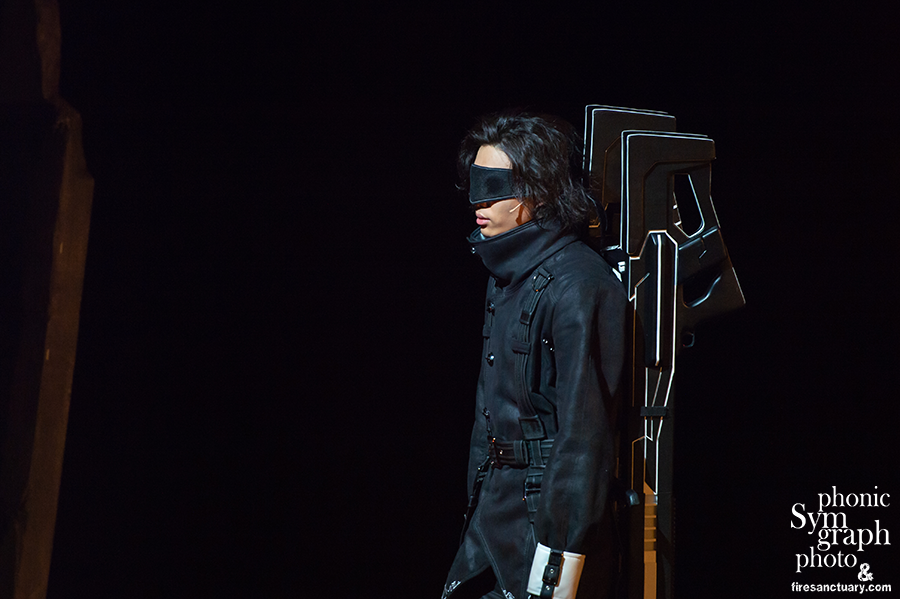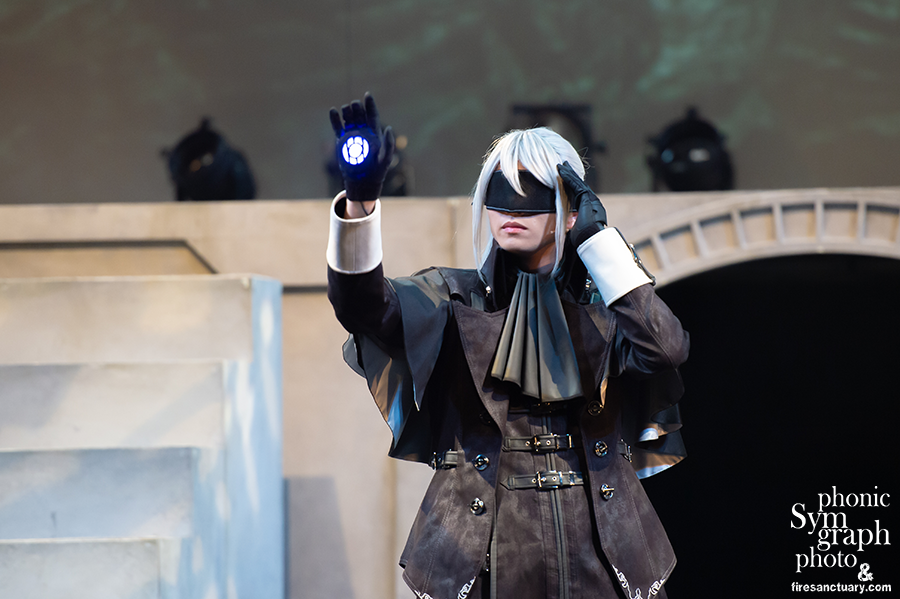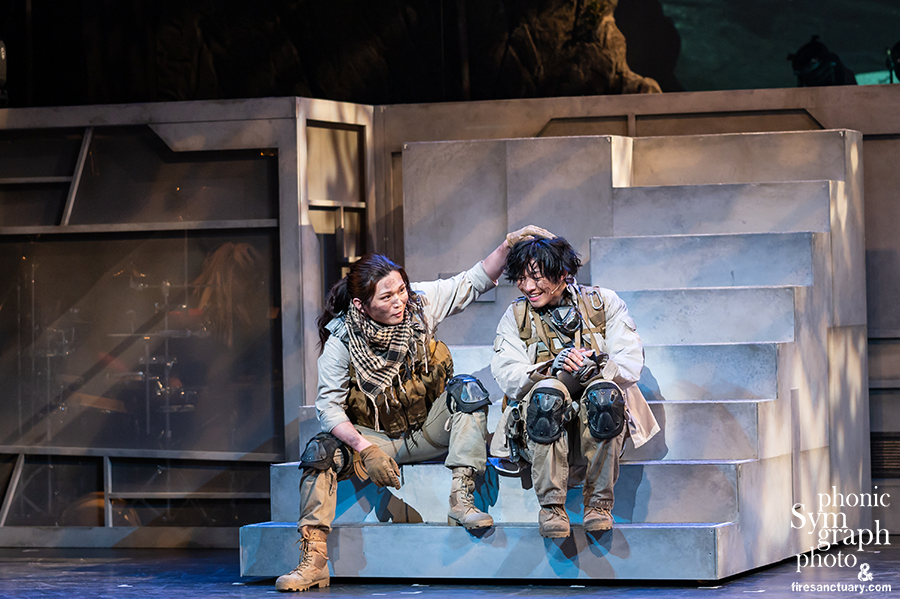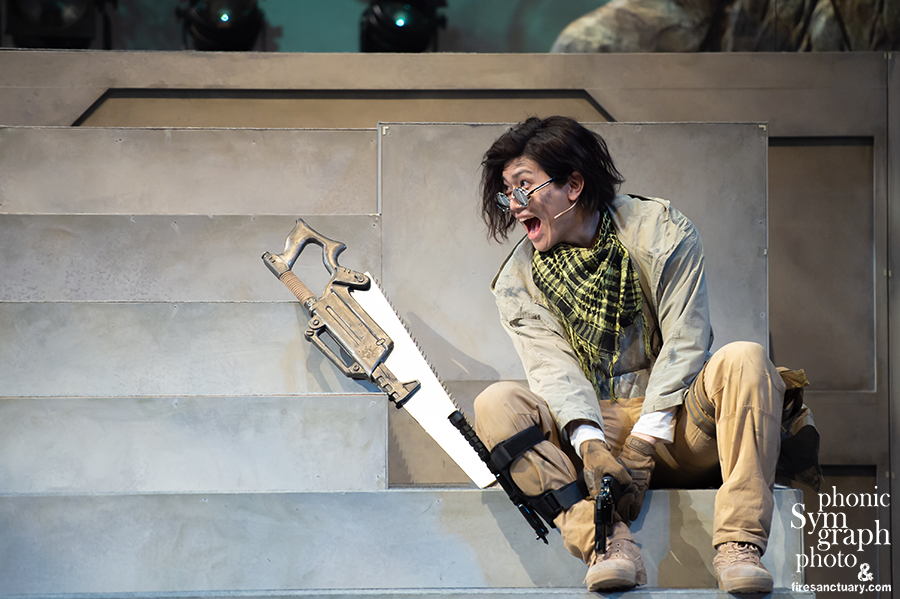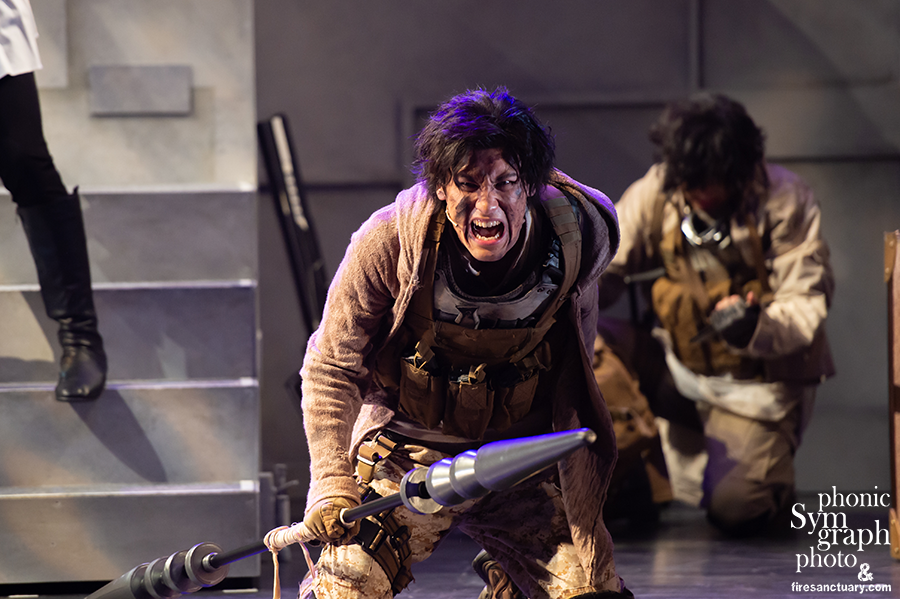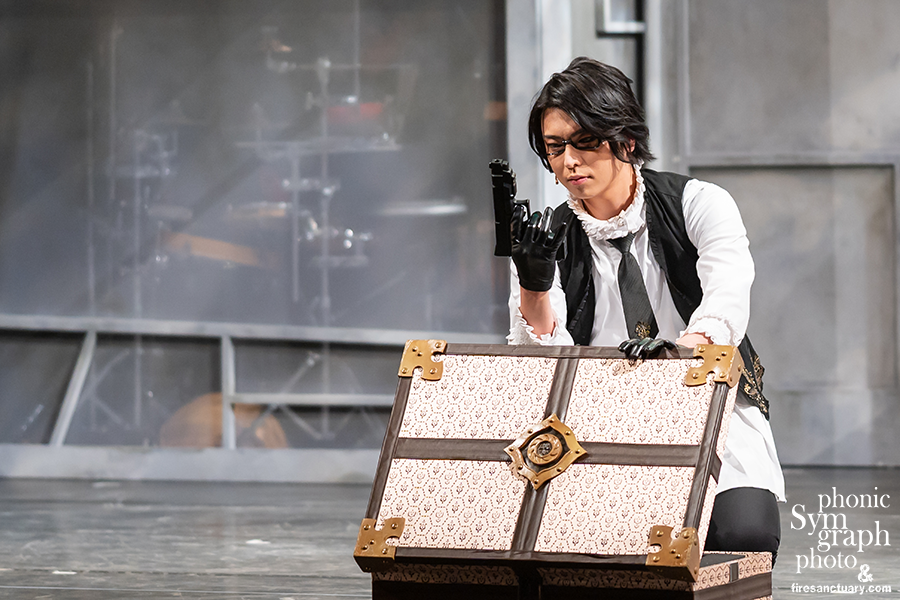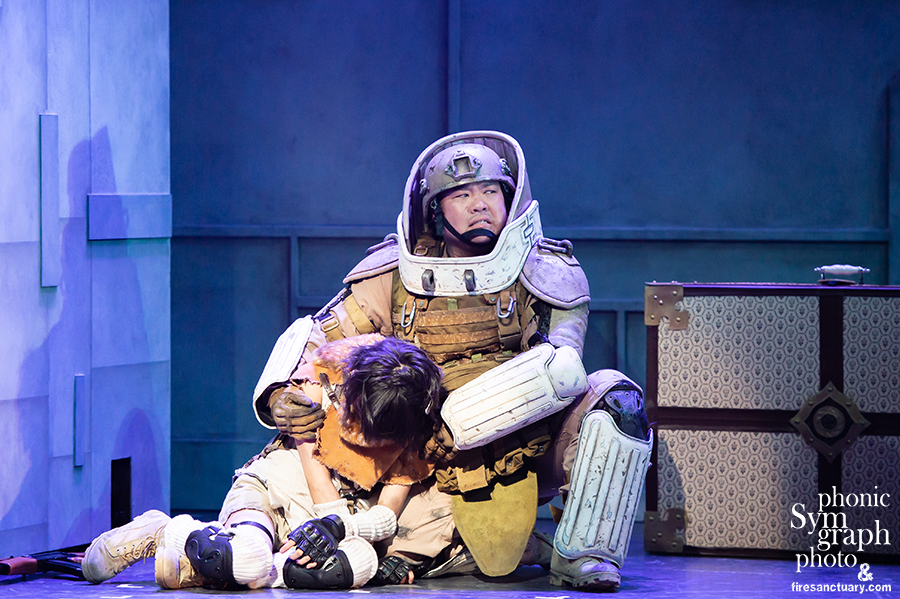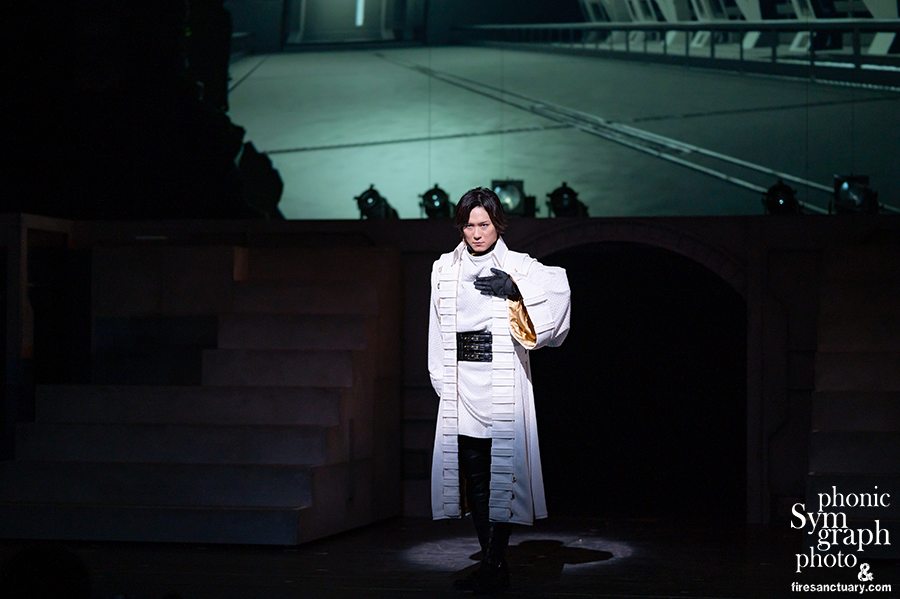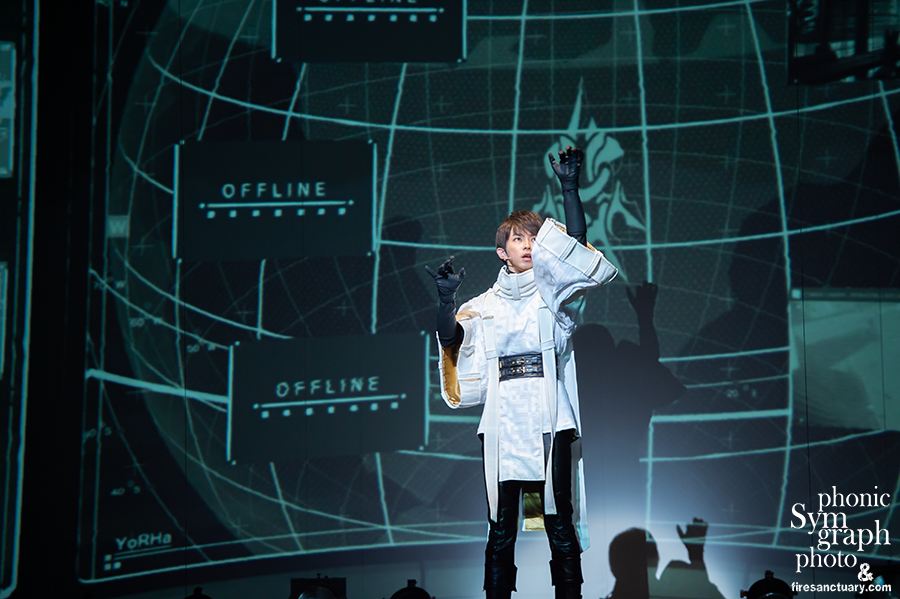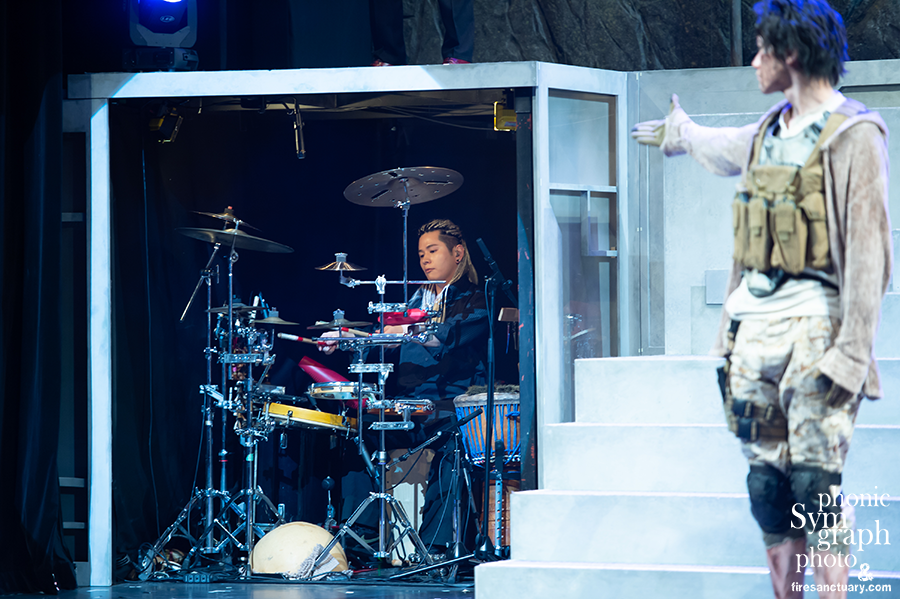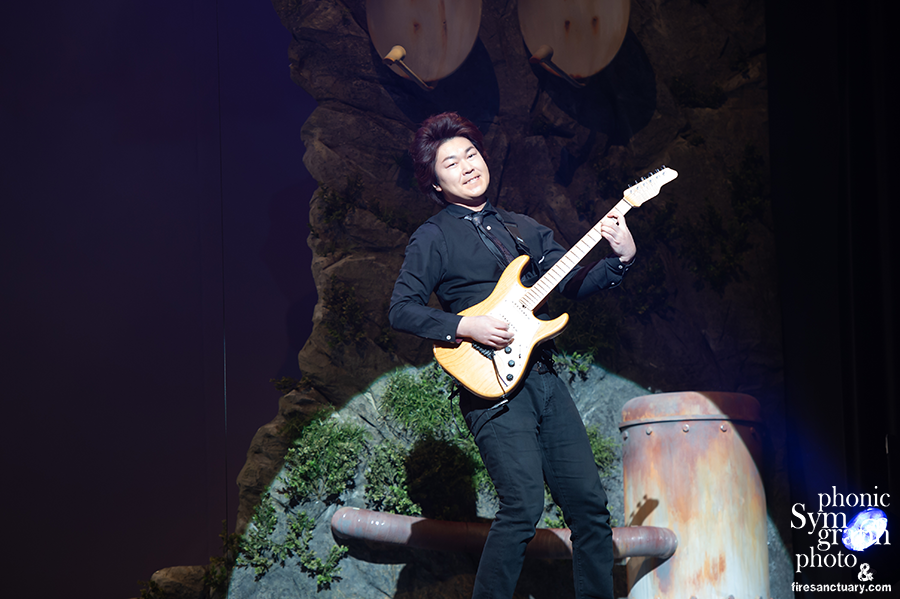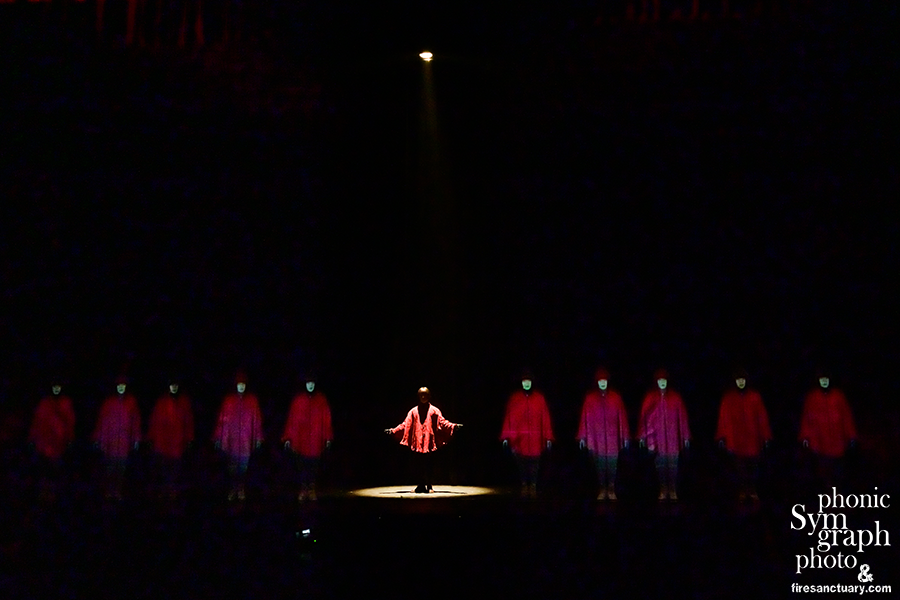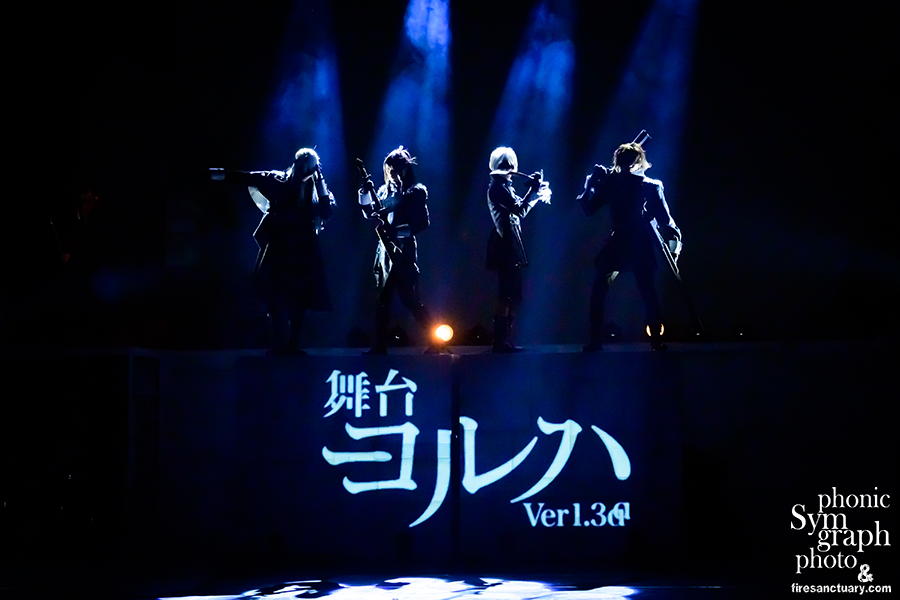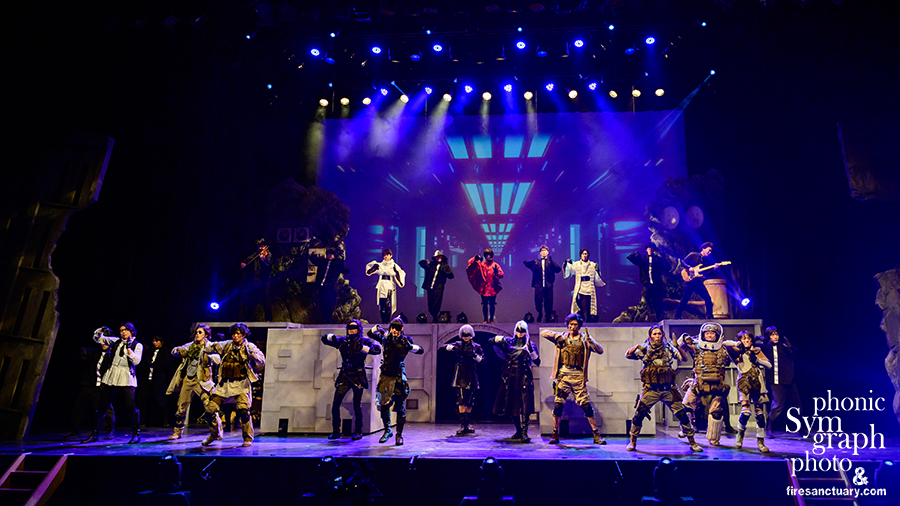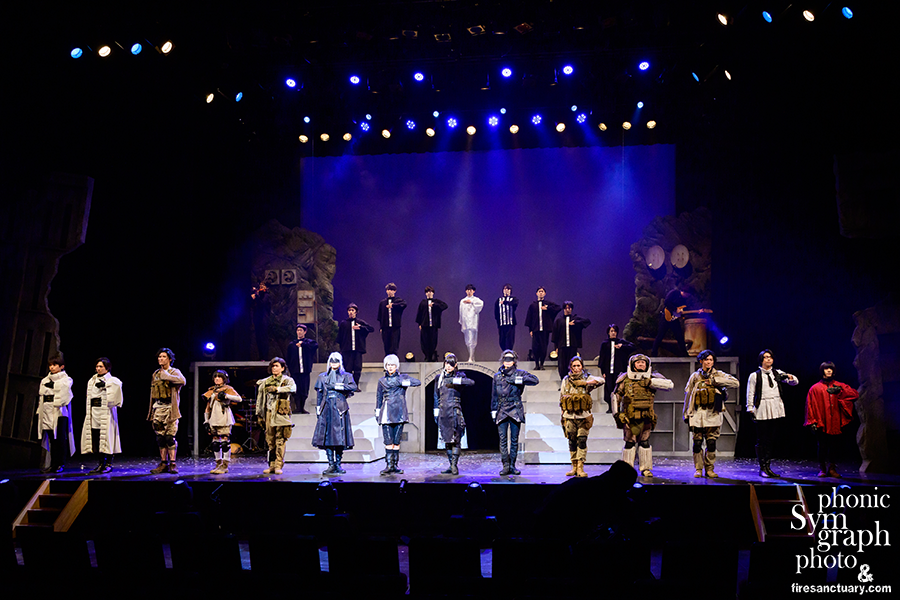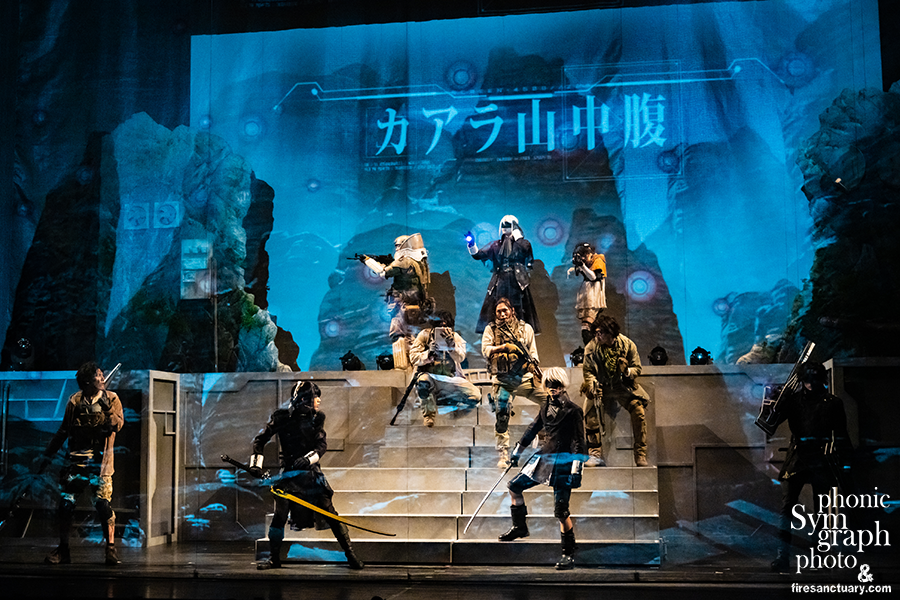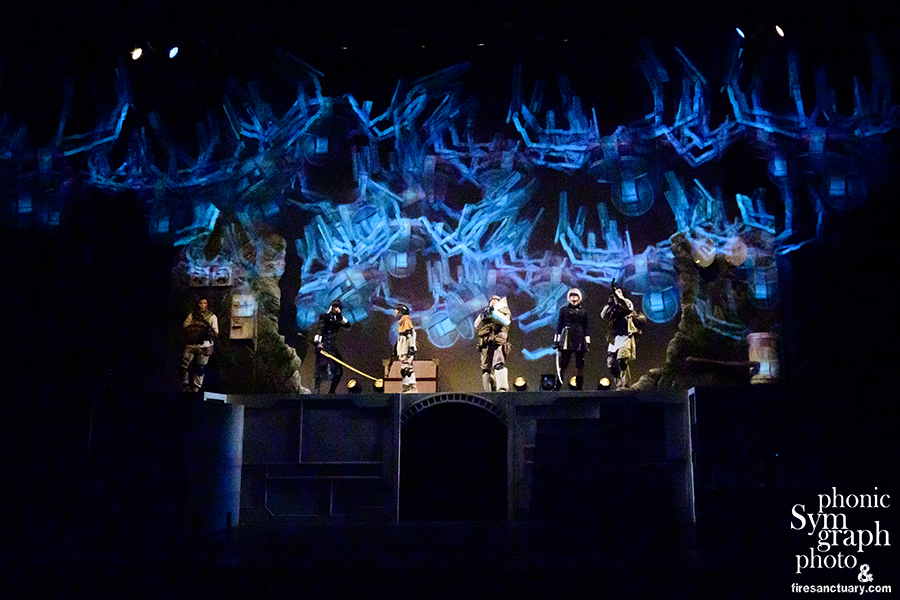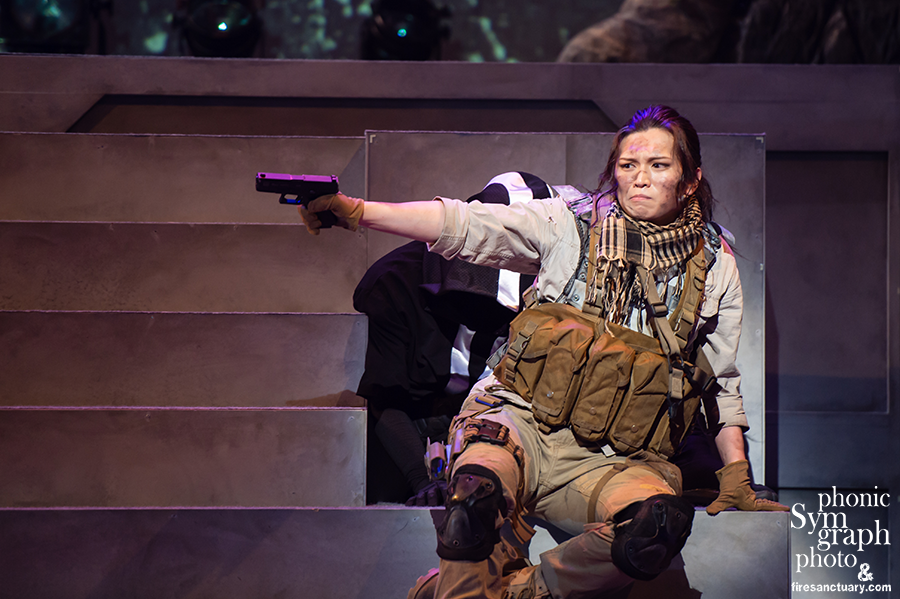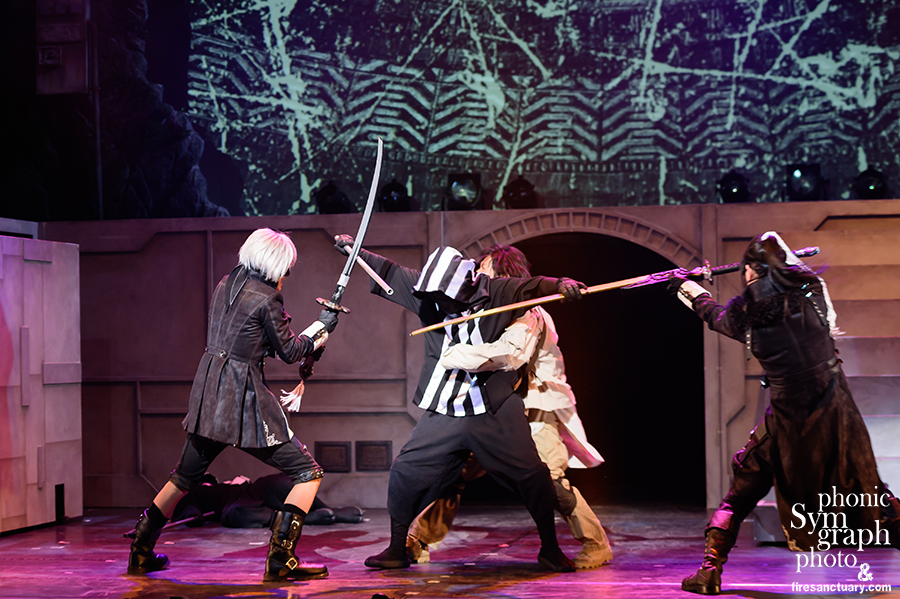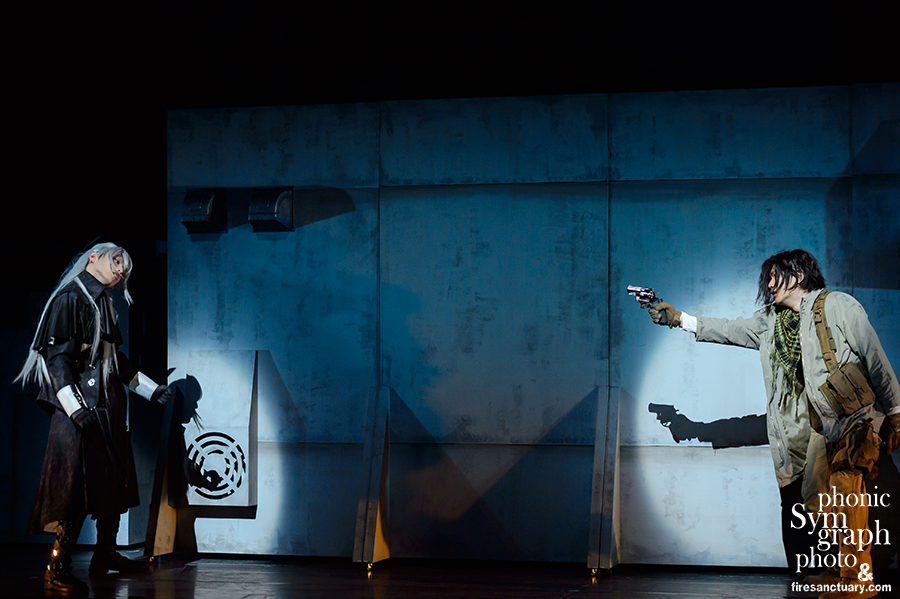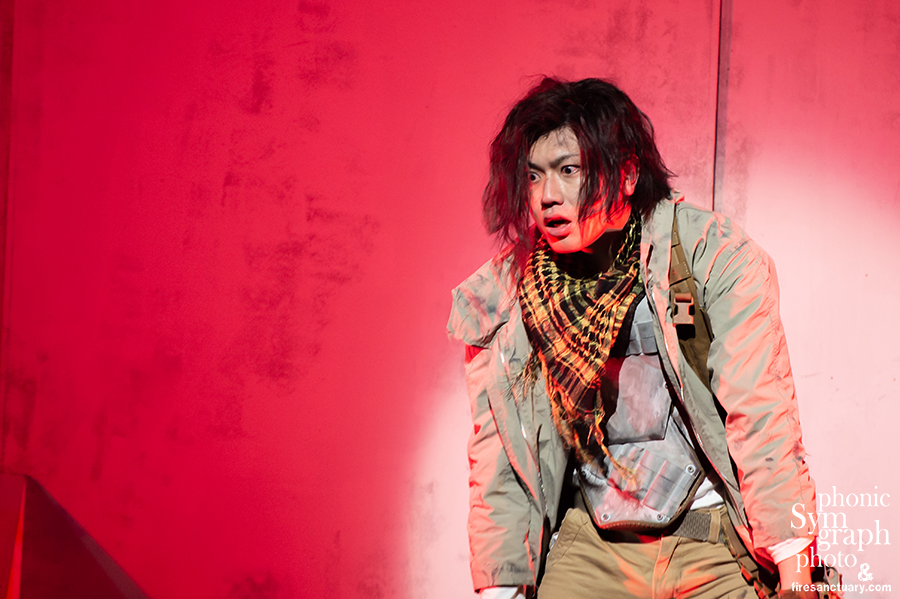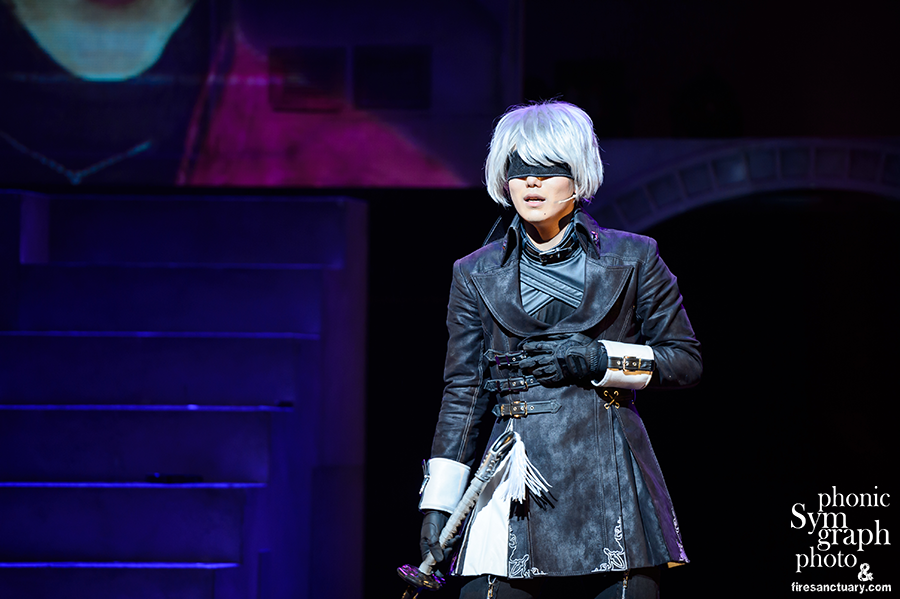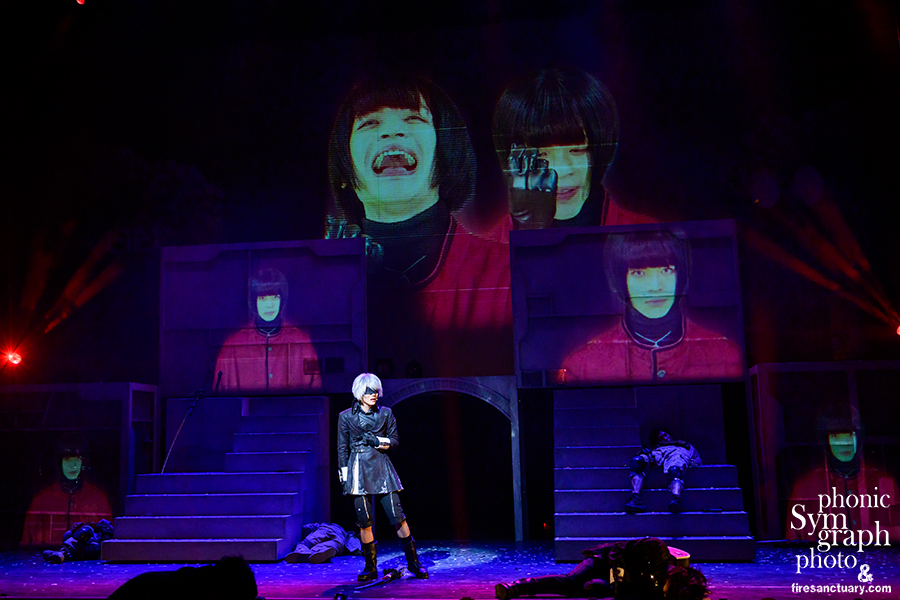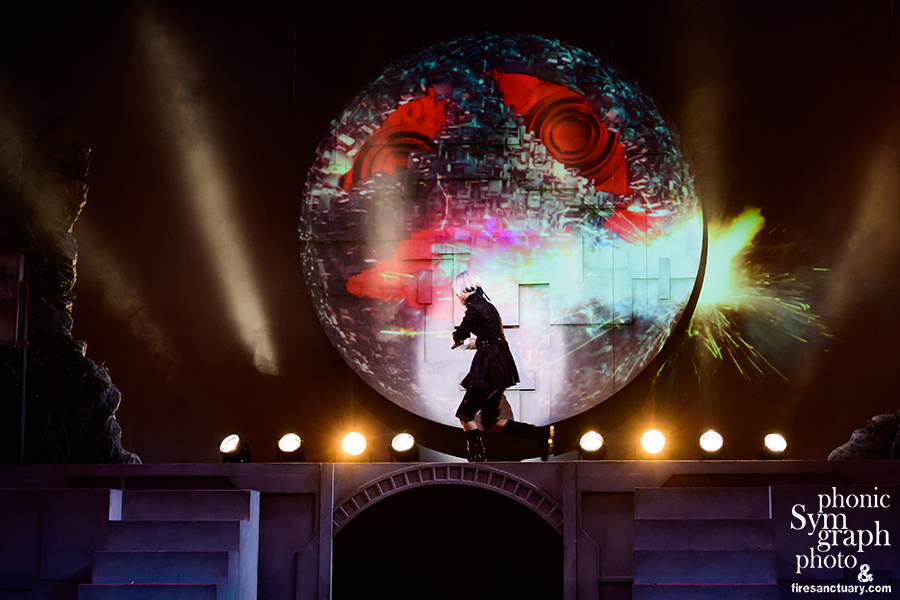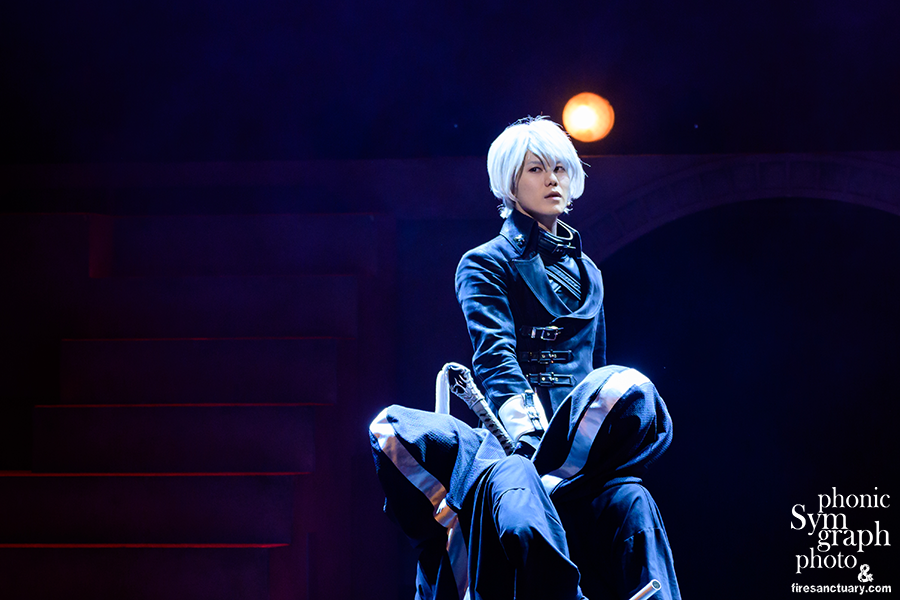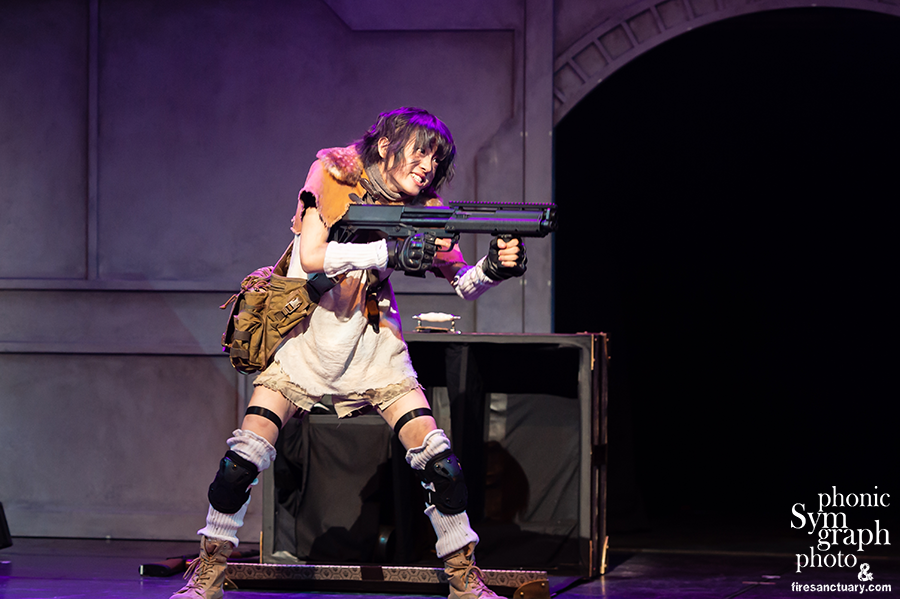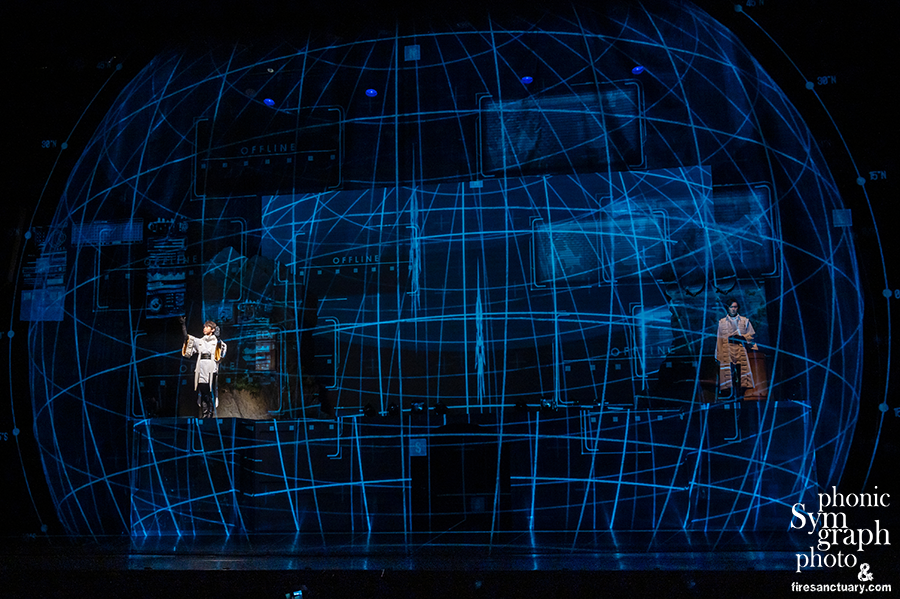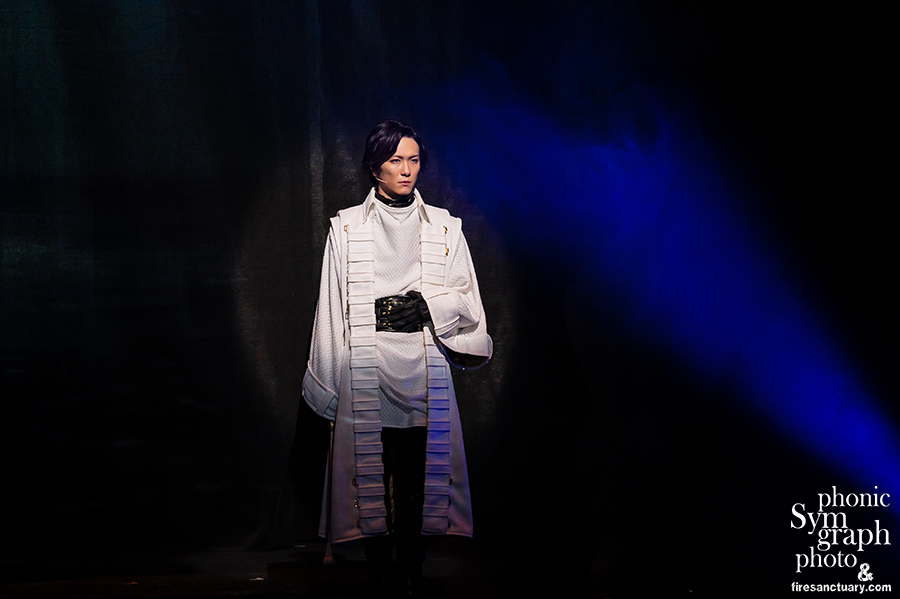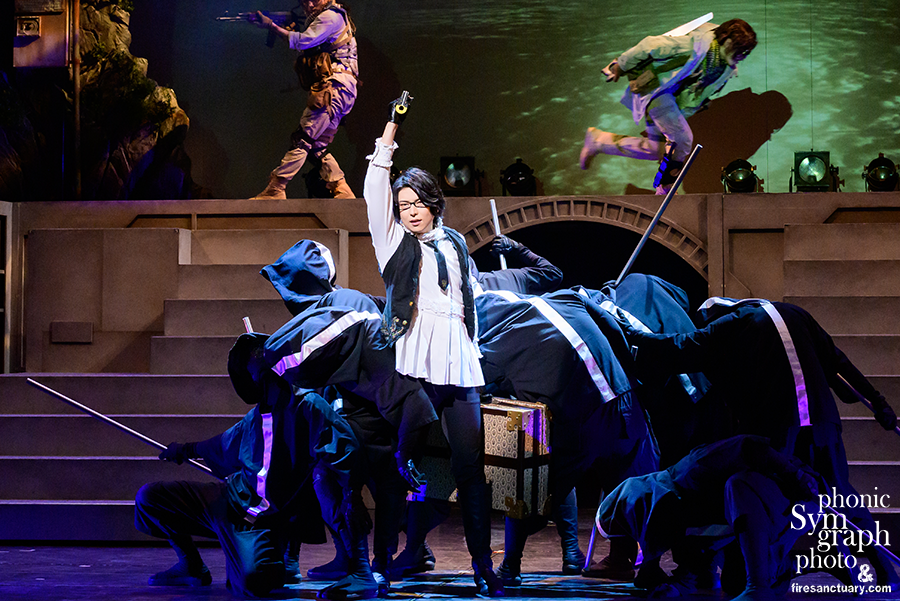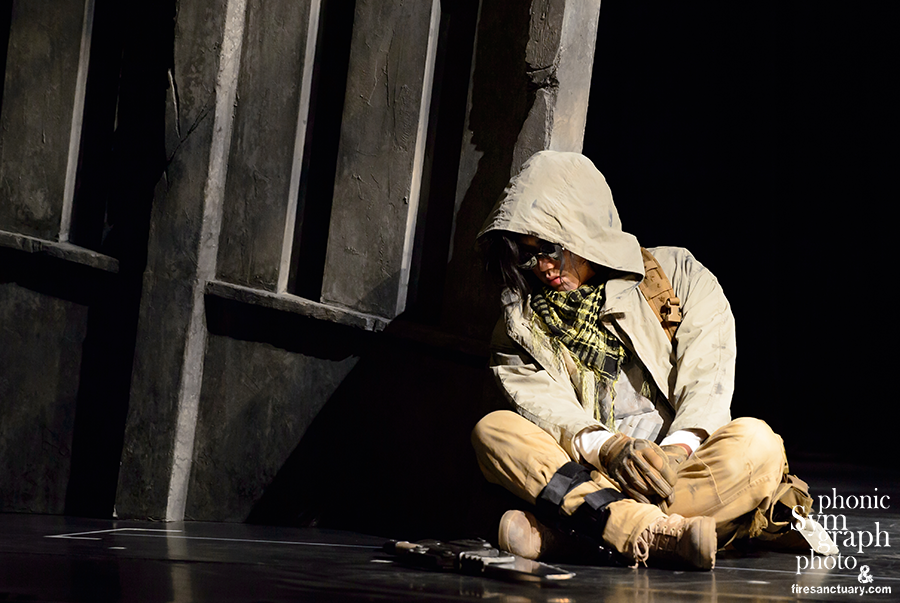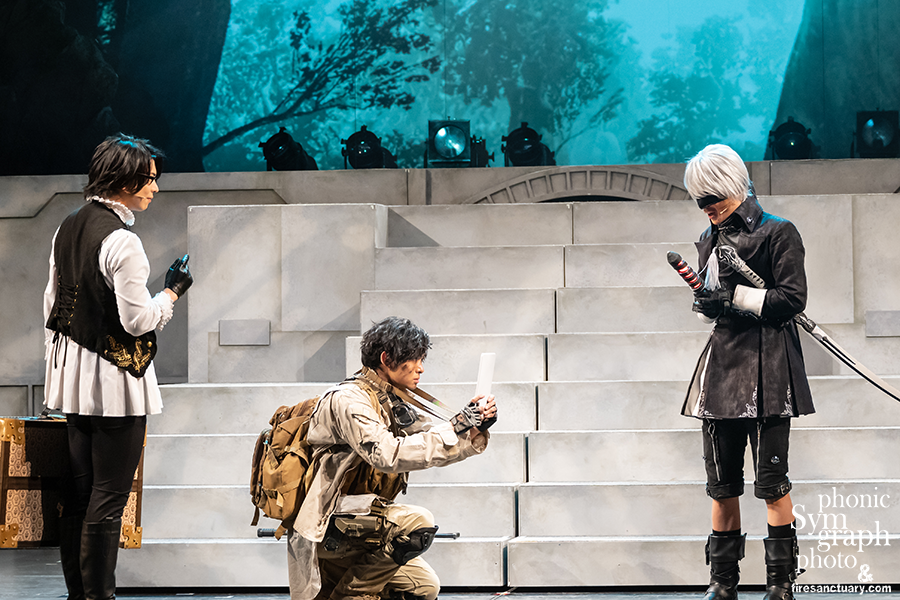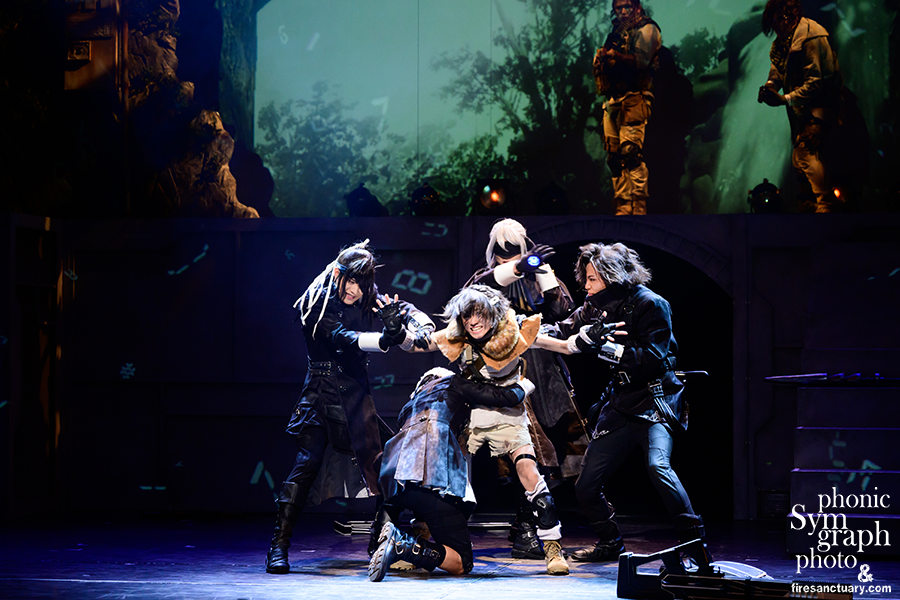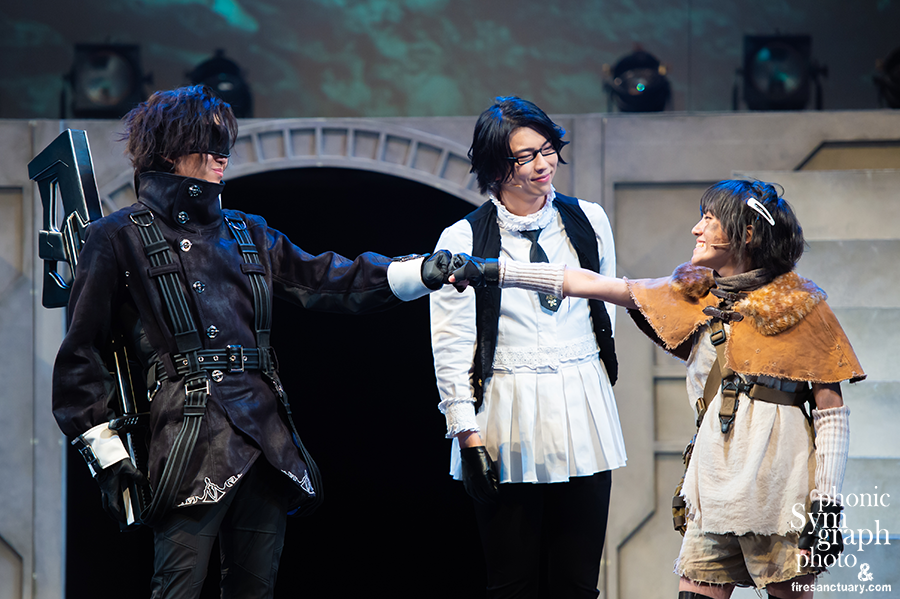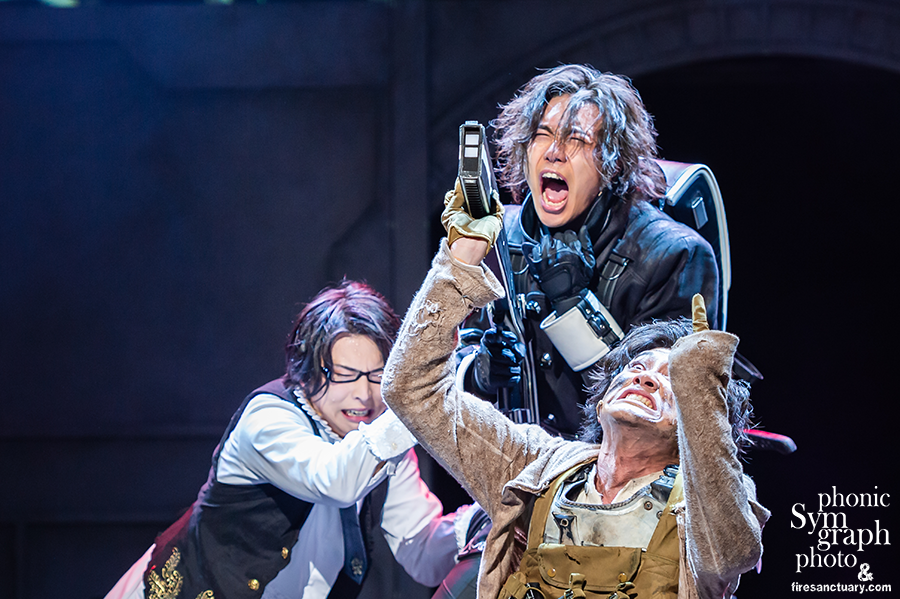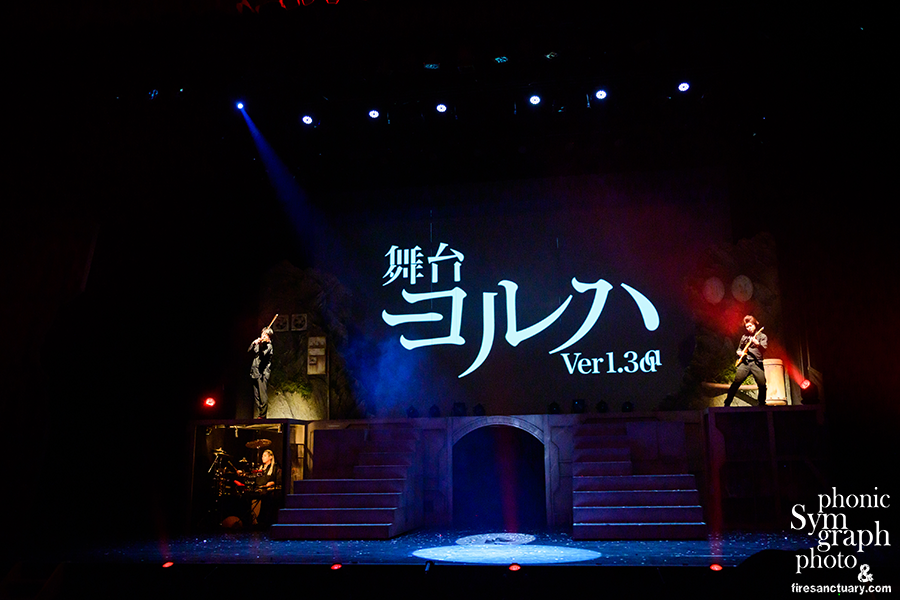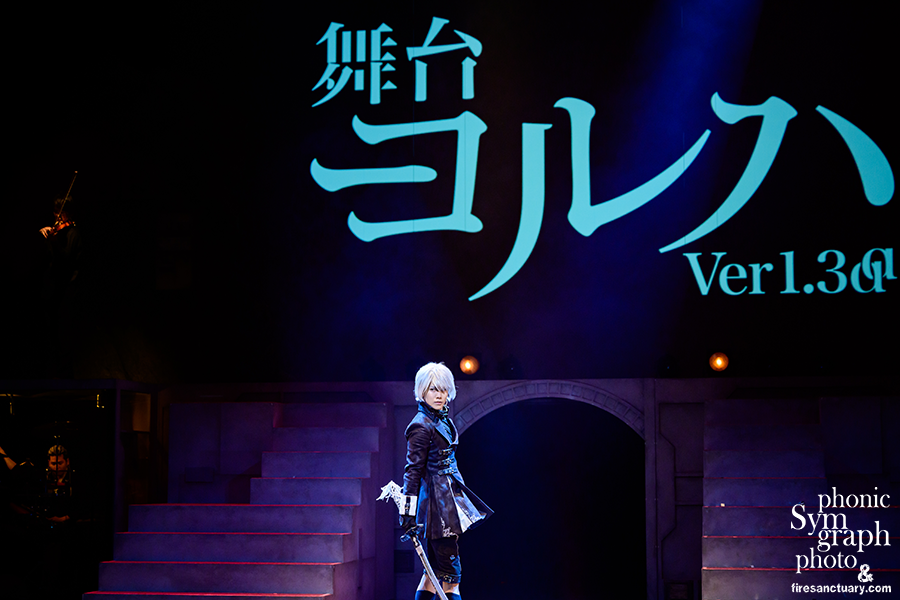
Swords, Sweat, and Tears:
The Classic YoRHa Stage Play Levels Up Big Time!
The stage “YoRHa Ver.1.3aa”, which shares the same world view of Square Enix’s Action RPG NieR:Automata was scheduled to have a week of performances this month, but due to the downfall of the Coronavirus pandemic, all of the public performances have been cancelled. That being said, practices progressed as scheduled for the livestream on March 29. This article depicts the details of the final practice performance, held on March 13.
CREDITS:
All images found on this page are copyright by Fire Sanctuary
in association with Square Enix and ILCA. All rights reserved.
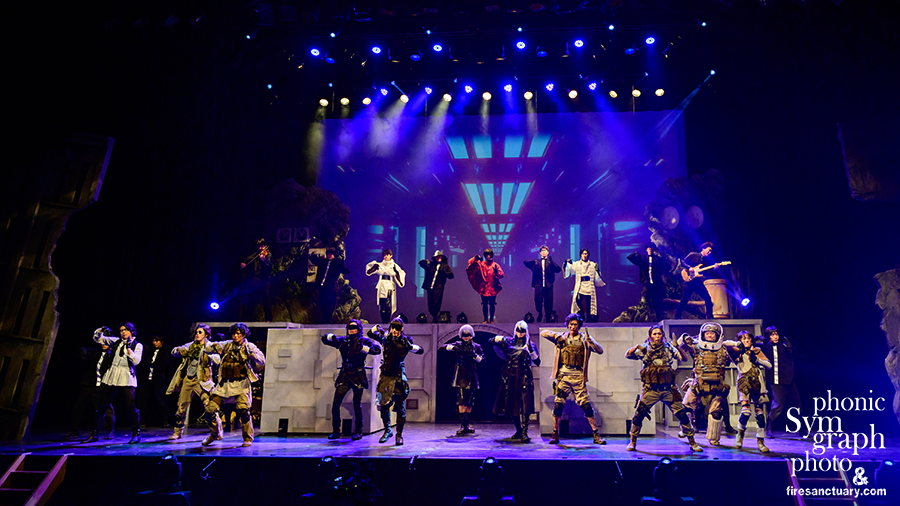
This is the 5th iteration of the YoRHa stage play which began with Ver.1.0 in October 2014, well before the development of NieR:Automata. The previous versions of the stage play have been portrayed by an all-female cast; however, this version features an all-male cast. Although the original script was penned by Asakusa Kaoru, NieR creator/director Yoko Taro worked on the script for this version. For any NieR fan this is definitely a must-see production, not to mention the music was produced by Okabe Keiichi from MONACA, so you will certainly hear many familiar, emotion evoking themes throughout the show!
The story of the play, as with all the previous versions, depicts the Pearl Harbor Descent Mission on December 8, 11941, essentially a prequel to NieR:Automata, although the stage play was produced many years before the game. In order to further develop the official release of the YoRHa androids, various experiments were necessary. This particular mission was part of the prototype experiments, which put the individual androids into impossible situations in order to obtain valuable battle data that would later be implemented into the standard YoRHa units. This particular mission began with 16 individual YoRHa prototypes, but was quickly reduced to a mere four units, the majority of the squadron destroyed by machine lifeforms upon descent from the Bunker. Once on the ground, the surviving four YoRHa come in contact with survivors from the previous Machine Wars, dubbed as the Resistance, and the two forces join together to complete the mission.
No2, the main protagonist of the play, is actually known as A2 in NieR:Automata. This particular story provides the character’s origin story and helps explain why the character is the way she is portrayed in the game. It was thanks to the struggles No2 endured during this mission that helped to create the later 2B model that we know from the game.
YoRHa Ver.1.3aa was scheduled to run from March 12-15, but due to an abundance of caution for the Coronavirus, the entire public performance was cancelled. In lieu of this unfortunate turn of events, the stage play was streamed in part of the NieR 10th Anniversary special livestream on March 29.

What’s New In This Version
As the 5th rendition of the original YoRHa stage play, Ver.1.3aa saw the most changes, the most obvious with the all-male cast. This added a very welcome change of atmosphere and helped to speed up the pace and intensity of the scenes.
With an all-male cast, the entirety of the play seemed to have a much faster and intense pacing, with a good portion of the story occurring before the traditional opening dance sequence to the song “Normandy”. I know I say it a lot, but the opening dance sequence is amazing! Part of the dance sequence remains the same from the very beginning, where they gesture motions that resemble the three wise monkeys: Mizaru, Kikazaru, and Iwazaru, aka “See no evil, hear no evil, speak no evil.”
In terms of the stage design, this version utilizes a mesh screen that periodically comes down for words or other video effects to be projected on it that seamlessly interacts with the cast in fast-paced action scenes or in dramatic monologues. It was a real treat to see when machines would drop from the ceiling or when robotic figures were projected on the screen only for them to be replaced by actual actors on the other side of the screen as it rises. It’s so difficult to retain a level of realism in stage plays, but the design for this play was absolutely top notch! So many of these effects looked and felt real, adding an additional layer of realism to those desperate fight scenes!
There were so many changes and alterations to the basic flow of the story that Ver.1.3aa almost feels like an entirely new play. Many characters are portrayed differently, new scenes help to flesh out the characters, and of course, throwing Accord into the mix is likely the biggest game changer of them all.

No2 is initially very skittish and unsure of his own ability to fight, often putting himself down in the process. Miyagi portrays the character with extreme precision, letting the character’s pure innocence shine through as one of the only rays of light in a very bleak battleground. It’s through experiencing such great pain and loss that create the strong and resilient character that we know in Automata.
As the actor of the lead role, Miyagi also acts as a leader for the rest of the cast, helping them to focus and work together as a team. Even though he has a very soft outward expression, he can be very serious about his craft and it’s amazing to witness! He has also done other non-stage acting work as well, so definitely keep an eye out for his other work as well!
Although the lead role of No2, portrayed by Miyagi Kodai, gives the audience a standard viewpoint into this crazy world wrought in war, the lead four YoRHa characters are what carry the narrative of the play, showing us the strength of their bonds and exactly what they will sacrifice for each other.
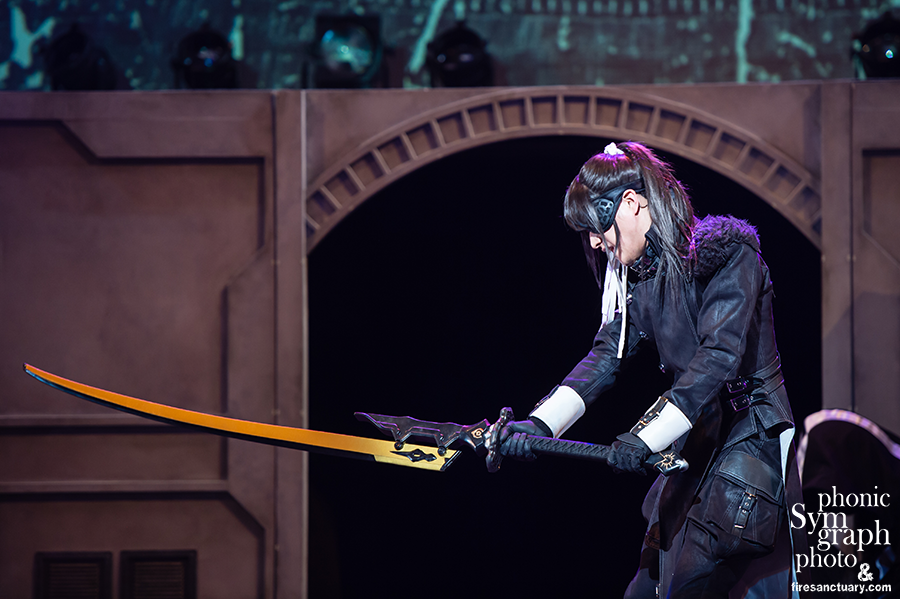
The character of No4, played by Ayagiri Takuya, has changed a little bit in this version to be a little more aloof in the face of danger due to his superior strength. He fully understands the drastic position they’re all in, how they’re all just sacrificial dolls to be used and later discarded. Even still, he sees something special in No2 and continually tries to help him become a good leader, whether it’s through sparring or in a serious pep-talk.
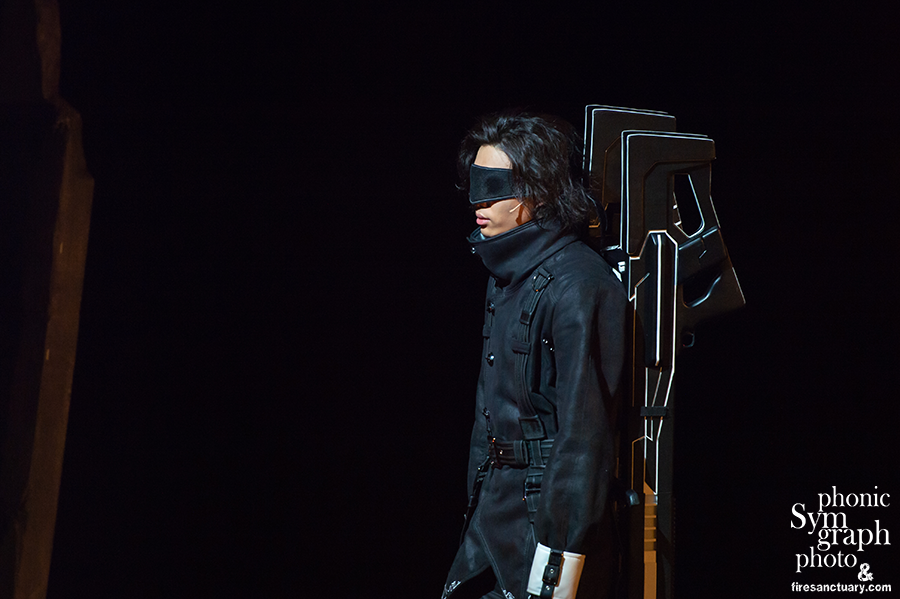
The role of No16, portrayed by Kimura Masataka, has always been one to shoot first, ask questions later. He is one of the first YoRHa to clearly see and understand the sort of predicament the team has fallen into, and therefore is quick to denounce Command in lieu of the team’s survival. Although he seems always at odds with Dahlia, they are very much two peas in a pod and actually make a good team.
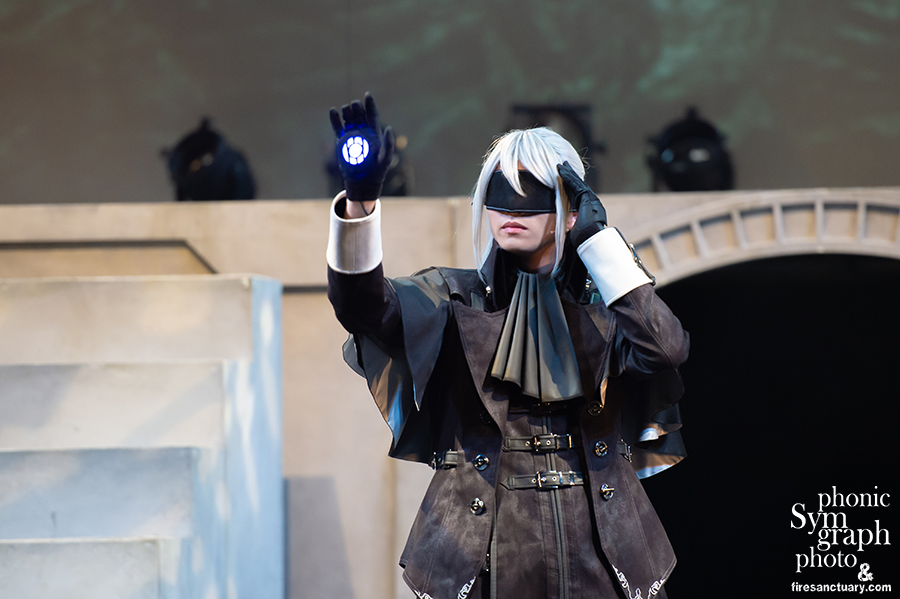
The role of Scanner No21, the only YoRHa android unequipped for hand-to-hand combat, plays the important role of mediator for the group, always acting according to logic rather than feelings. Portrayed by Kominami Kouji, No21 shows his great inner strength by refusing to merely sit on the back benches while the others do all the fighting. This sometimes places him at immense personal risk, but his sense of logic has the upper hand over his own fear.
The background of the Resistance has changed slightly in the 1.3 versions of the play, depicting them as deserters. This change helps to personify the members while adding a vital part to Lily’s background as well.
Rose, the Resistance leader played by Akaba Mio, is as powerful a character as ever! With the entire safety of the Resistance on his shoulders, he is initially very wary of the appearance of the YoRHa, but gradually he begins to trust and open his heart to them, especially when they all share the same overall plight. Seeing the role be portrayed by a male actor was very interesting. Along with his second in command, Gerbera, the two are considered by fans to be the “father” and “mother” figures of the Resistance, and they are super cute together!
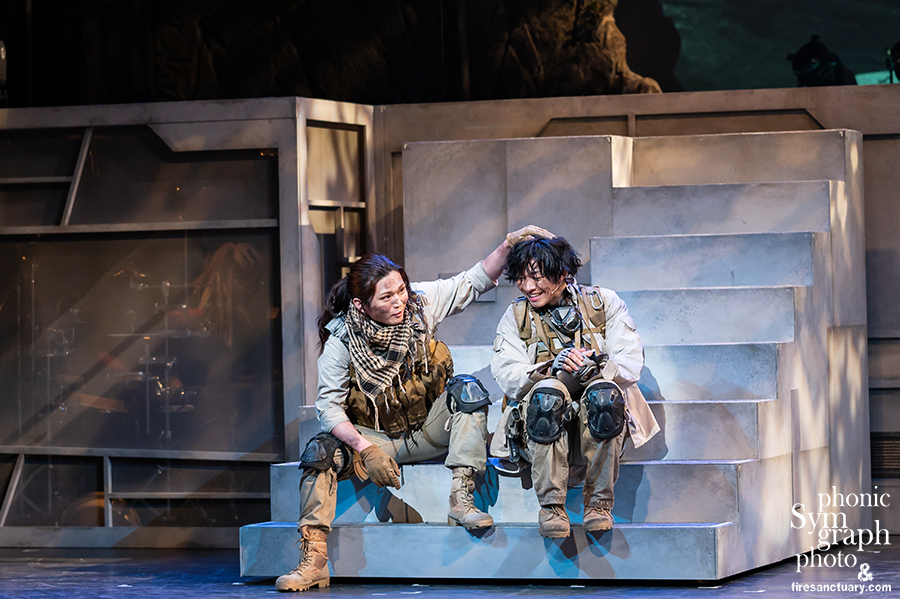
Gerbera, played by Kanno Yuuki, has actually changed quite a lot through the various versions of the stage play. In the earlier versions, she was a pretty nondescript member of the Resistance, but with the removal of Kalmia in Ver.1.2, Gerbera became a sort of weapons dealer for the Resistance. Always obsessing over new technology and weaponry, Gerbera was portrayed as pretty high-strung and a little crazy. This time, however, Gerbera was much calmer than before since Accord took up the role of the weapons dealer.

Although all previous versions of the YoRHa stage play also depicted the appearance of Anemone, who also makes an appearance in NieR:Automata, due to the unavailability of the original actor who played the role of Anemone, this version of the play replaces Anemone with Jackass, played by Kurotaka (Kuroki Fumitaka). For the most part, the major story points remain the same, but with the addition of Jackass, who on the surface, appears to be the “mad scientist” sort of character, really begins to open up toward the end. As the strongest member of the Resistance, he carries both a Machine Sword and a small revolver, sometimes using both weapons at the same time.
Some of the absolute best moments of the play come with the unexpected addition of Accord to the cast, which was apparently Sekiya Makoto’s idea one time when he was out discussing the play with Yoko and the gang! Most of you who are familiar with the works of Yoko Taro will recognize Accord from Drakengard 3, although in the actual game, Accord was a female type android.
Throughout much of Drakengard 3 and the companion manga Utahime Five as well as her appearance in SINoALICE, Accord is an interesting character full of strange quirks (like grabbing Zero’s breasts from behind for no apparent reason) who is thoroughly enshrouded in mystery. Even to this day, we still don’t have a clear understanding of who or what she/he is. Although we know so very little about Accord, from their actions and genuine desire to change an unpleasant fate, I think we can conclude that Accord is very much a “pure” type character, which is extremely rare within Yoko’s works. Exactly how far this sense of purity goes is unknown, but Accord constantly puts herself/himself into harm’s way if there is a slight chance to create a better future.
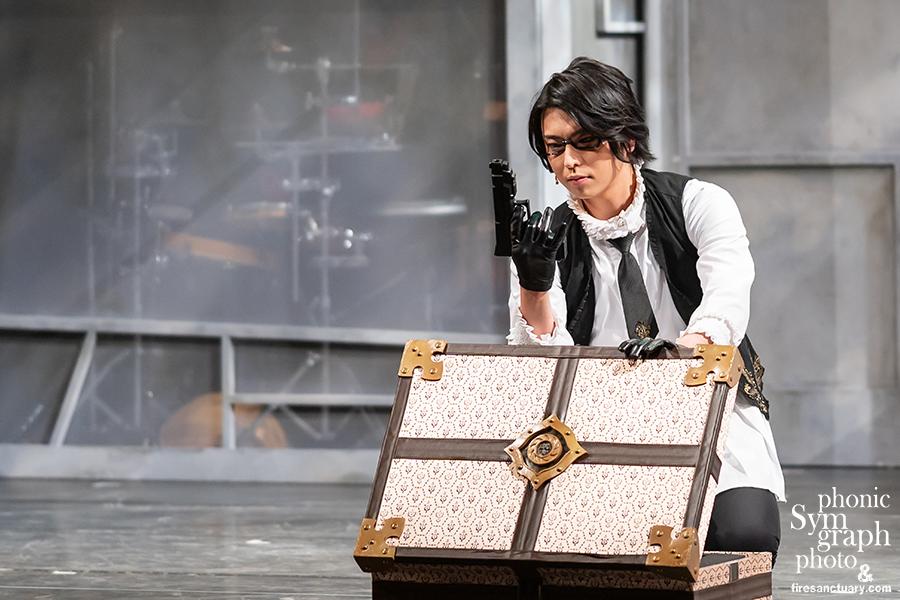
Regarding Accord’s appearance in both 1.3 versions, he is considered part of the Resistance, supplying them with weapons to fight the machines as well as offering tactical support in combat. This particular role originally belonged to Kalmia, a character which has sadly been written out of the play since Ver.1.2. Simply, because of his uncanny ability to die and seamlessly reappear later an infinite number of times, many of the Resistance members resent and even fear him. But is he really immortal…?
Suga Kyousuke portrays Accord with such mastery and charm; he was easily the crowd’s favorite in Ver.1.3a and Ver.1.3aa and I can only imagine the same will be true for this newer version! I must admit as well, Accord has easily taken up the position of “my favorite character” in the play, right up there with No2! Amazing! Be sure to watch out for this mysterious character!
All About Accord
Originally appearing in Drakengard 3, the companion manga series Utahime 5, and as a DOD3 collaboration character in SINoALICE, the addition of Accord in this version of the stage play was originally Sekiya Makoto’s idea. He dropped the idea when he, Yoko Taro, and others were out drinking one night, and he basically mentioned, “Wouldn’t it be interesting if Accord showed up?” Yes. Absolutely. It is incredibly interesting.
Let’s review what we know about Accord:
- Her role in DOD3 was that of a recorder. She was tasked with the job of recording the events throughout time as it related to the “Singularity” aka Zero. Eventually through her observations, she began to feel a genuine connection with Zero and eventually went against the “golden rule of time travel” by not interfering in events by helping Zero find her “good ending”.
- Accord has been recording world events throughout the timeline including various diverging branches, but we don’t exactly know the origins of Accord at this point. We know she is an android that is able to “save” her memory to be reinstalled into a new android body when the previous has been destroyed. This extended memory or maybe it’s own consciousness is unique among all androids, so much so that she seems to exist outside of the normal flow of time. This also allows her to somehow travel to any point in time.
Dahlia, played by Jinza Kei, was one of the characters that perhaps changed the least throughout the different versions of the play. He was always a formidable rival to No16, each of them sharing the same sort of hard-headed stubbornness. What I really enjoyed with this Dahlia was all of his hilarious facial expressions and silly lines. There is one in particular that made me and the rest of the audience laugh every, single time! In the majority of his scenes, he has such a stern scowl on his face, but deep down, he has a very soft heart. There is an extremely emotional scene where this side of him starts to peek through his harsh, scowling gaze… Maybe he just has a hard time expressing his emotions?
I am probably the most happy with the changes that were done with Lily and Daisy. Without giving too much away, I can say that the new character background that was given to Lily fleshes out the character so much better, although in a very tragic way. He’s no longer scared of everything around him for no apparent reason. Lily, portrayed by Koga Ruito, the youngest member of the cast (He just graduated from junior high the other day! Congrats!), brings such warmth and vitality to the role in silly scenes and such pain and anguish in serious moments. Koga is already a masterful actor at such a young age!
As for Daisy, this was actually a new addition since Ver.1.2. There were some nice scenes with Daisy in that version, but I couldn’t help but notice the way the character was used as merely a tool for comedic effect given her large size. In Ver.1.3a/aᵃ, however, the character seems much more developed, and he’s given a very vital role later on that absolutely tugs at the heartstrings of the audience. Portrayed by Yano Takeshi, he effortlessly displays Daisy’s sincere emotion toward his comrades. Daisy has such a personable and cheerful demeanor, he helps to balance out the other dark and brooding Resistance members. Watching Yano’s performance, it is impossible not to emote during those most powerful scenes toward the end…
Seeing Commander White be portrayed by a male actor was very interesting for me, having seen the YoRHa Boys stage play in 2018; I couldn’t help but think how this version of White resembled Black from that play. Generally speaking, the Commander in the stage plays is rather full of emotion. Merely, it is his duty that causes him to reign in those messy emotions for the sake of the mission. The way his story plays out is completely different from all other versions of the play, so it’s quite the treat to see. The Ver.1.3aᵃ Commander, played by Kasahara Orito, is also quite a bit different from Ver.1.3a, especially in his verbal treatment of Wakaba.
Wakaba, the main Operator on the Bunker played by Sato Tomohiro, was another character like the Red Boy that was originally portrayed as two separate characters. Throughout the course of the play Wakaba’s character is slowly developed as he gets more and more emotionally involved in the Pearl Harbor Descent Mission and the plight of the YoRHa androids. There were several moments where I couldn’t help but draw connections between him and 9S.
Term Omega is further personified on stage as they duplicate him in a very eerie way that perfectly calls back to moments in NieR:Automata. This was something very new in this version of the play, since in all past versions, there were always two separate actors portraying the so-called Red Girls, Term Alpha and Term Beta. This time, however, we have just one actor, Tanaka Hiroki, portraying a new representation of the Machine Network, Term Omega. Although he’s just one person, he speaks lines with multiple different voices to represent that he’s not exactly one, singular individual, but rather… many. Ver.1.3aa expands on the thought of evolution for this character as well, having his voice sound very robotic at the beginning which gradually shifts to a more playful, almost child-like voice near the end of the play.
The Machine Lifeforms were also depicted in interesting ways for this version of the play. Wearing all black, loose-fitting ninja garb, the ensemble cast depicted various types of Machine Lifeforms by the number of white stripes they wore. Some had one stripe, others two, but one of the strongest of the machines had four stripes. What’s interesting about this is that with each addition of a white stripe, their garb gets more and more full of white. Perhaps the strongest machine the YoRHa will face in this version will be a completely white machine? With all of Yoko’s works, he certainly likes to use color to represent unique concepts that often go against common thought (ie. white representing purity/virtue).
Music Brought to Life
Both Ver.1.3a and Ver.1.3aa featured live musical performances by guitarist Goto Takanori, violin by Shirasu Kon, and percussion by Fukuoka Takashi. Although all three of these talented musicians also have many other various gigs they’re involved in, Goto is a long-time performer for the NieR, YoRHa, and SINoALICE series, while Shirasu was the main arranger and concertmaster at the SINoALICE concert in November 2018. Fukuoka, according to both he and Famitsu, is apparently a game fan who lost to the two CEOs in the NieR:Automata DLC over 50 times. He’s certainly got more tenacity than me! It’s always an absolute pleasure to watch these guys perform live! I cannot help but get excited when the YoRHa theme songs “Normandy” and “Guadalcanal” begin to play!
They are all cleverly hidden within the stage design, performing within large boxes that are occasionally opened to reveal them rocking those amazing YoRHa and Automata tunes! At some pivotal moments during the play, Goto and Shirasu sometimes appear on the second floor stage platform for added effect. Watching Goto rockin’ out to “Normandy” in the opening sequence is always a pleasure!

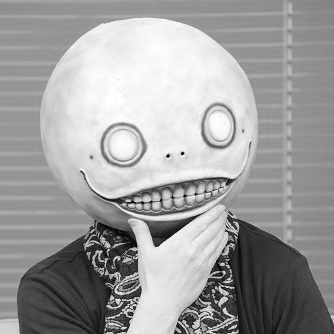
Yoko Taro, Creator – Bukkoro
URL | Twitter
Games: DOD, NieR, NieR:Automata, SINoALICE
Manga: Utahime Five, Shi ni Itaru Aka, Thou Shalt Not Die
Stage: YoRHa, Thou Shalt Not Die Zero, Thou Shalt Not Die Zero_KAI

Matsuda Ichidai, Director – DearStage / Actor’s Trash ASSH
URL | Twitter
YoRHa Ver.1.0-Ver.1.3a
YoRHa Boys Ver.1.0
Thou Shalt Not Die Zero, Thou Shalt Not Die Zero_KAI

Okabe Keiichi, Composer – MONACA
URL | Twitter
NieR Gestalt / Replicant
Drakengard 3
NieR:Automata
SINoALICE


No2
Miyagi Koudai
宮城 紘大

No4
Ayagiri Takuya
綾切 拓也
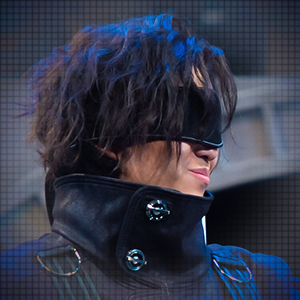
No16
Kimura Masataka
木村 優良
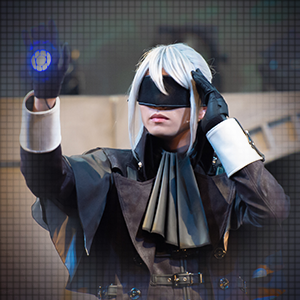
No21
Kominami Kouji
小南 光司

Rose
Akaba Mio
紅葉 美緒
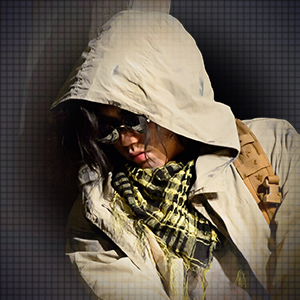
Jackass
Kurotaka
黒貴

Lily
Koga Ruito
古賀 瑠

Gerbera
Kanno Yuuki
菅野 勇城

Dahlia
Jinza Kei
神坐 慶
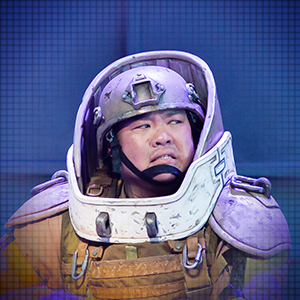
Daisy
Yano Takeshi
矢野 たけし
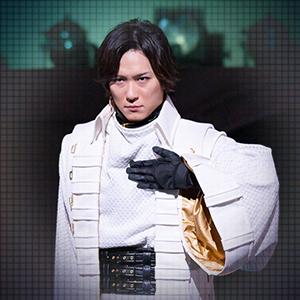
Commander
Kasahara Orito
笠原 織人
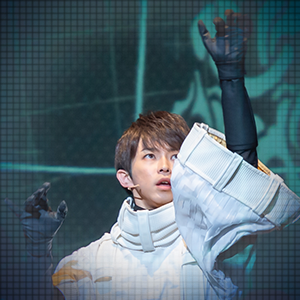
Wakaba
Sato Tomohiro
佐藤 智広

Red Boy
Tanaka Hiroki
田中 宏輝
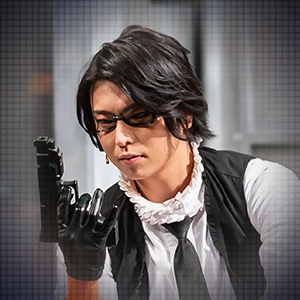
Accord
Suga Kyousuke
須賀 京介
The Ensemble Cast
- Kuramoto Akira / 倉本 晃良
- Nora Souru / 野呂 奏流
- Oda Toshiki / 織田 俊輝
- Iihara Yu / 飯原 優
- Oda Tatsuya / 太田 達也
- Uetasu / うえたす
- Kakegawa Touma / 掛川 冬馬
- Iyoda Yoshihiko / 伊与田 良彦 (White Machine)
- Hayashi Hiroki / 林 宏樹 (4 Stripped Machine)
Voice Overs
- Akiyama Kaoru / あきやまかおる
- NieR:Automata (Pod153), YoRHa Boys (SS)
- Yasumoto Hiroki / 安元 洋貴
- NieR:Automata (Pod042), “Project YoRHa” Recitation Drama (Zinnia)
The Music Team
- Guitar: Goto Takanori / 後藤 貴徳
- Drakengard 3, NieR:Automata, etc.
- Violin: Shirasu Kon / 白須 今 [Official Website]
- SINoALICE Concert, Aoi Eir Tour 2015, Kuwana Masahiro Blue Note Live 2012
- Percussion: Fukuoka Takashi / 福岡 高次
The History of YoRHa
If you’re asking yourself, “What is this YoRHa thing? Is this a game? A movie?”, well, let me briefly explain!
YoRHa Ver.1.3aᵃ is the 5th iteration of the YoRHa stage play which first ran for roughly a week in October 2014.
YoRHa Ver.1.0 – October 2014
YoRHa Ver.1.1 – May 2015
YoRHa Ver.1.2 Musical – February 2018
YoRHa Ver.1.3a – July 2019
Originally as a collaboration between Yoko Taro and his two college buddies, Iwasaki Takuya (ILCA) and Okabe Keiichi (MONACA), this was Yoko’s first break into the world of idols. Three idol singers from DearStage, also run by Iwasaki, were chosen to form the group “YoRHa” and also perform the boss battle themes from Drakengard 3. A special audio CD with the two songs “Normandy” and “Guadalcanal”, which also included a booklet with a brief story outline and character statistics. It was this basis that later became what we know today as the YoRHa stage play, staring a completely female cast. This version of the play was released on a 2-disc set DVD in February 2015, including both the Heaven and Earth dual casts of actors.
Since 2014, the play has gone through several upgrades and revisions. The first update came with YoRHa Ver.1.1 in May 2015, where Yoko penned several new scenes. The venue was also moved over to Shinjuku Mura LIVE, a much larger theater where the play was given much more room for technical upgrades in the actual theater. Unfortunately, this version of the play was never released on DVD.
Moving further to the release of NieR:Automata, it became apparent that the fundamental basis of the story for the game came from Yoko’s original stage play idea several years previous. I was beyond shocked when I watched the announcement from E3 that year because I knew exactly what the YoRHa were…
A year after the release of NieR:Automata, Yoko released the third version of the stage play, upgrading it further to complete “musical” status. Not only did it receive new scenes, but many of the characters were reworked, removed entirely, or merged with other characters to create an almost entirely new production. Unfortunately, with this version of the play, some of my most favorite scenes and characters were removed. Nonetheless, the venue was the perfect fit to continue the stage advancements that we saw with Ver.1.1. With a larger budget comes a much better display on stage. As the name suggests, the musical version was the first time live musical performances were used, including the addition of two additional songs with lyrics penned by Yoko Taro.
Following in this tradition of upgrading the play with each production, YoRHa Ver.1.3a comes across as nearly an entirely new stage play although its heart is still very much the same. It’s all the little bits in the middle, the intimate relationships between characters, depictions of how this particular “alternative” timeline unfolds, not to mention the all-male cast, that make this version of the play a very satisfying watch.
Some people might confuse this stage play, both Ver.1.3a and Ver.1.3aᵃ, with the other all-male YoRHa Boys Ver.1.0 stage play that premiered early in 2018, but these two plays depict completely different stories, so please try not to confuse them.
For more detailed information on the history of YoRHa, please check here!
Comment by Guitarist Goto Takanori
Last [time], I not played the guitar for the YoRHa Ver.1.2 Musical, but I was also allowed to mix the stem data. I was in charge of isolating the various live performance parts (violin, piano, guitar) and mixing them to fit the timing of the play.
For this version of the play, I met with the director well before the script had been finalized, and he gave me several keywords for the types of musical pieces he wanted, such as themes evoking fear and sadness, battle sequences, and more. Based on these keywords, I selected several pieces from NieR and arranged multiple short versions of the songs. Then the director selected the ones he liked and applied them to appropriate moments during the play.
Since many themes have been used in other orchestras and concerts by now and the arrangements this time called for only a guitar, violin, and percussion, I really thought hard about how to arrange the performances with this unique grouping. I don’t think you can hear anything similar to this anywhere else.
So with that in mind, I hope you can come and hear what it sounds like for yourself!!
Image Gallery

- Sekiya Makoto – ILCA
- Urano Masaki – Studio Symgraph
- Goto Takanori
人類に栄光あれ!
GLORY TO MANKIND!



